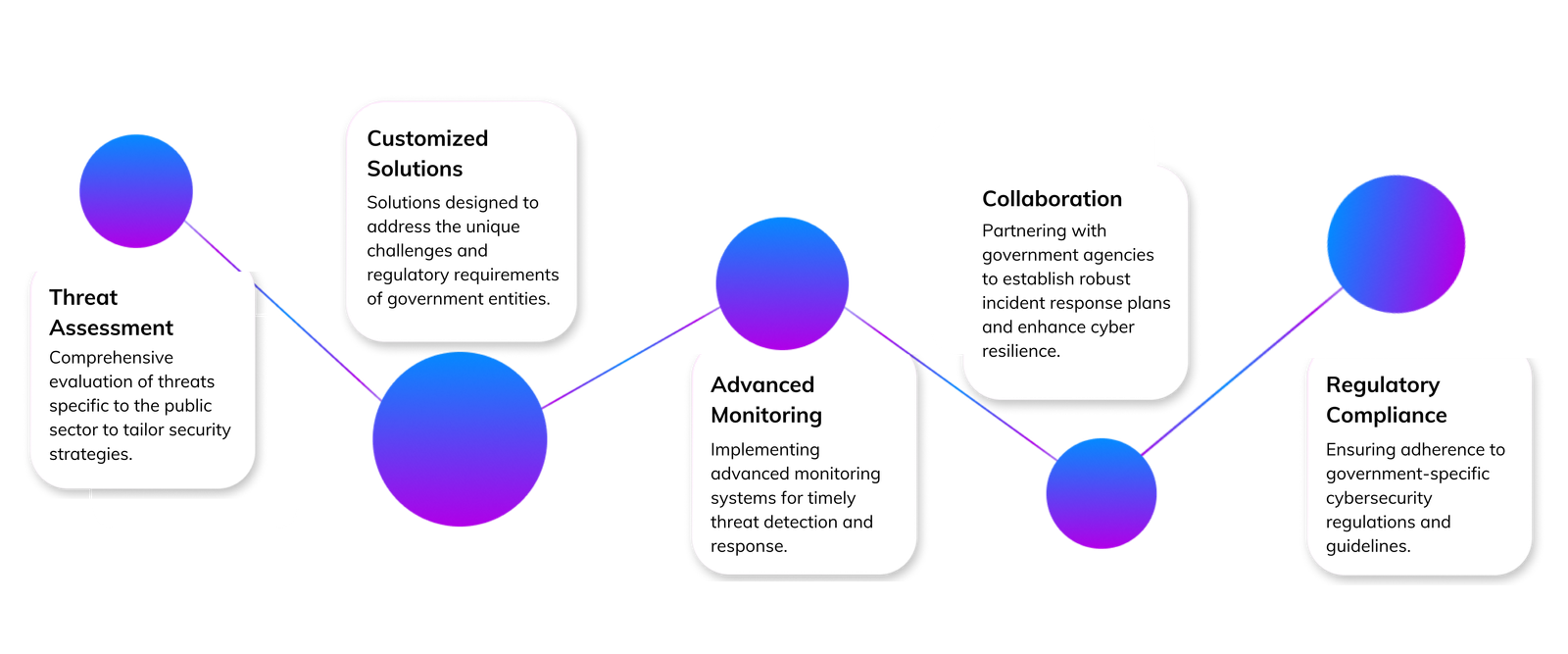Governments with Advanced Cybersecurity Solutions | Lumiverse Solutions
In today’s rapidly evolving digital landscape, governments are increasingly at risk of sophisticated cyber threats. From protecting critical infrastructure to securing sensitive data, the public sector faces unique challenges in safeguarding their digital assets. Lumiverse Solutions, a leading cybersecurity firm with offices in Nashik and Dubai, offers comprehensive cybersecurity solutions tailored to meet the complex needs of government institutions. Cyber security in government agency.
Understanding Government Cybersecurity Challenges
Nation-State Attacks: Governments often face threats from other countries seeking to destabilize or extract sensitive information. Cyber security in government agency
Data Privacy Concerns: Public institutions handle vast amounts of citizens’ data, making them vulnerable to breaches and unauthorized access.
Compliance & Regulations: Governments must comply with strict cybersecurity regulations such as GDPR, NIST, and ISO standards. Cyber security in government agency
Critical Infrastructure Protection: Cyberattacks on energy grids, water systems, and transportation can lead to national crises. Cyber security in government agency
Evolving Threat Landscape: The rise of AI-powered attacks and zero-day vulnerabilities demands continuous monitoring and response. Cyber security in government agency

Our Government Cybersecurity Solutions
Lumiverse Solutions offers a range of cybersecurity services designed specifically for government agencies. Our solutions provide multi-layered defense mechanisms that safeguard your digital infrastructure and ensure compliance with the highest security standards. Cyber security in government agency.
Governance, Risk & Compliance (GRC) Services
Our GRC services ensure that your systems comply with international and local regulatory requirements. By conducting in-depth risk assessments and audits, we help you mitigate risks, align with regulations, and achieve security objectives.
Digital Forensics & Incident Response (DFIR)
In the unfortunate event of a cyberattack, our expert DFIR team is on hand to help your organization respond swiftly and effectively. We investigate incidents, contain threats, and recover lost data, ensuring that your operations can return to normal with minimal disruption. Cyber security in government agency.
Vulnerability Assessment & Penetration Testing (VAPT)
Our VAPT services help identify vulnerabilities before attackers do. We conduct thorough security testing across your IT infrastructure, networks, and applications to expose weak points and provide actionable recommendations.
Operational Technology (OT) Security
Protecting critical infrastructure such as power grids, transportation systems, and public utilities is vital to national security. Lumiverse Solutions specializes in securing OT environments from advanced threats, ensuring the continuous and secure operation of essential services. Cyber security in government agency
Cybersecurity Training & Awareness
We provide tailored training programs designed to educate government employees on the latest cybersecurity best practices. This training ensures that staff are aware of potential threats and know how to respond effectively to any incidents.
Why Choose Lumiverse Solutions for Government Cybersecurity?
At Lumiverse Solutions, we understand that the security needs of government institutions are unlike those of any other sector. Our approach combines advanced technology with a deep understanding of the unique challenges facing Cyber security in government agency.

Tailored Solutions
We don't believe in a one-size-fits-all approach. Our cybersecurity experts work closely with your IT and security teams to design solutions that are custom-built for your organization's specific requirements.

Global Expertise, Local Presence
With a strong presence in both Nashik and Dubai, we provide governments with world-class cybersecurity services while offering the personal touch and responsiveness of a local firm.

Compliance-Driven Approach
We ensure that your security infrastructure complies with industry-leading regulations and standards, including GDPR, NIST, ISO 27001, and other regional compliance mandates.

24/7 Monitoring and Response
Our security operations center (SOC) provides round-the-clock monitoring and real-time response to potential threats, ensuring that any vulnerabilities are addressed before they can be exploited.
Discover how vulnerable your systems are with our free Vulnerability Assessment and Penetration Testing.
Our Approach to Cybersecurity for Government and Public Sector
Lumiverse’s tailored approach for the manufacturing industry includes

Key Elements of a Government Cybersecurity Framework
A robust cybersecurity framework is essential for manufacturing organizations to effectively manage and mitigate risks associated with cyber threats. At Lumiverse Solutions, we utilize a comprehensive framework based on industry best practices to ensure the protection of your critical assets and operations. The framework consists of five core functions: Identify, Protect, Detect, Respond, and Recover. Here’s how each component contributes to a resilient cybersecurity posture:
Identify: Assessing Risks and Critical Assets
The first step in any cybersecurity framework is to identify and assess the critical systems, data, and infrastructure that must be protected. For government agencies, this includes:
Critical Infrastructure: Power grids, water supplies, transportation systems, and other essential services.
Sensitive Information: Citizens’ personal data, classified government information, and other sensitive records.
Third-party Access: Any vendors or partners who have access to government systems must also be identified and managed.
This phase involves a thorough risk assessment to understand the potential threats, vulnerabilities, and impact of attacks on these critical assets. Cyber security in government agency
Protect: Implementing Security Measures
Once risks have been identified, the next step is to develop and implement protective measures. In the context of a government cybersecurity framework, this includes:
Access Controls: Establishing strict access policies to ensure that only authorized personnel can access sensitive data and systems.
Data Encryption: Ensuring that sensitive information is encrypted at rest and in transit to prevent unauthorized access.
Network Security: Implementing firewalls, intrusion detection systems (IDS), and intrusion prevention systems (IPS) to monitor and protect network traffic.
Endpoint Protection: Securing all devices used by government employees, including computers, smartphones, and tablets, from malware and other threats.
Regular Patching and Updates: Ensuring that all software and systems are regularly updated to fix vulnerabilities.
Detect: Monitoring for Threats
Effective detection is key to preventing cyberattacks before they cause significant damage. A cybersecurity framework for government agencies should incorporate continuous monitoring to detect anomalies and unauthorized activities. Key strategies include:
Security Information and Event Management (SIEM): A SIEM solution provides real-time analysis of security alerts generated by applications and network hardware.
Network Monitoring Tools: Monitoring the entire network infrastructure for suspicious traffic and potential breaches.
Behavioral Analytics: Using advanced tools that analyze the behavior of users and systems to detect insider threats or malicious activity. Cyber security in government agency
Respond: Incident Response Plans
Despite the best preventive measures, cyberattacks may still occur. A well-structured incident response plan is essential for minimizing the impact of an attack and recovering quickly. Cyber security in government agency. In a government cybersecurity framework, incident response includes:
Incident Response Team: Establishing a dedicated team to handle security incidents and breaches.
Communication Protocols: Ensuring clear lines of communication between different departments, external stakeholders, and law enforcement agencies.
Containment and Mitigation: Rapidly containing the attack to prevent further damage, followed by steps to mitigate the impact.
Forensics: Investigating the breach to determine the root cause and prevent similar incidents in the future.
Recover: Restoring Services and Learning from Incidents
Once a security incident has been contained, the recovery process begins. Cyber security in government agency. This phase of the cybersecurity framework focuses on restoring normal operations, recovering lost data, and ensuring that lessons learned from the incident are incorporated into future security strategies. Key elements include:
Data Backup and Recovery Plans: Regularly backing up critical data to ensure it can be restored in the event of a breach.
Business Continuity Planning: Ensuring that government operations can continue even in the face of a major cyber incident.
Post-Incident Review: Analyzing the incident to identify weaknesses in the security framework and updating policies and controls accordingly.
Frequently Asked Questions
Governments around the world face ever-evolving cyber threats that jeopardize critical infrastructure, sensitive data, and national security. At Lumiverse Solutions, we provide tailored, cutting-edge cybersecurity services designed specifically for government agencies. From protecting against sophisticated cyberattacks to ensuring compliance with international security standards, we are committed to safeguarding your digital assets and ensuring uninterrupted operations.
Government agencies manage critical infrastructure and vast amounts of sensitive data, making them prime targets for cyberattacks. Cybersecurity ensures the protection of public data, national security, and uninterrupted services, safeguarding the nation from cyber threats.
Common frameworks include the NIST Cybersecurity Framework, ISO/IEC 27001, and COBIT. These frameworks provide structured guidelines for assessing risks, protecting assets, and ensuring compliance with national and international regulations.
Government agencies follow strict regulations such as GDPR, NIST, and ISO standards. Regular audits, risk assessments, and continuous monitoring help agencies maintain compliance with these frameworks and protect sensitive information.
Incident response is critical for minimizing the damage of cyberattacks. A well-defined incident response plan ensures swift action in detecting, containing, and mitigating threats, allowing agencies to recover and learn from incidents effectively.

